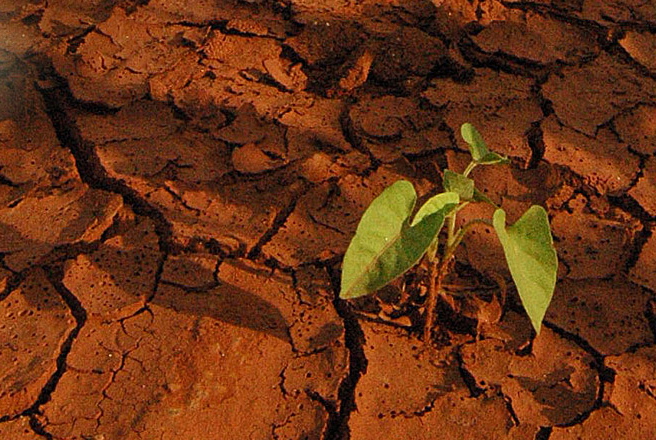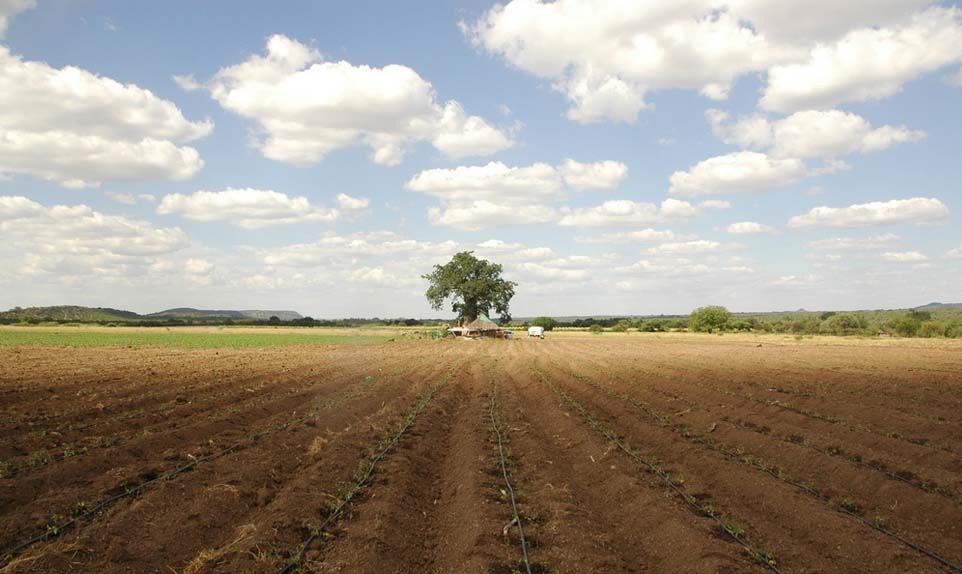
Makuleke, a village of small mud-walled houses with tin roofs in South Africa's Limpopo province, is a dry place in a dry land. Rainfall there, near the country's border with Zimbabwe, is low by most standards; about the same as rainfall in Montana.
Philemon Makamu, a farmer in Makuleke, gestures toward a garden planted in corn, pumpkin, watermelon and peanuts. His friend Reckson Josini squats to the ground to grasp a corn stalk gingerly in his hands. "You can see how it suffers," say Makamu.
The plant is green, but its stalk is stunted. Its leaves are curled, as if to escape from the sun. Josini explains that this year has been worse than the normally-marginal conditions. Rainfall has been about half the average. "We are running out of water," says Josini. "If the rain comes next week, there is hope that next week it will come then it will become OK."
This growing season started out okay; then the rains abruptly stopped. In contrast to the rest of the world African farmers like those of Makuleke are extraordinarily dependent on rainfall. About forty percent of arable land in Asia is irrigated. In sub-Saharan Africa, the figure is only four percent. Geographer Peter Johnston of the University of Cape Town says all of Africa will become warmer over the next century, and less rain will fall on large swaths of the southern countries of South Africa, Zambia, Mozambique, Namibia and Zimbabwe during what is already each year's dry season.
For Philemon Makamu in Makuleke, tilling his garden is already risky business. "We gamble on farming, he says. "If you are lucky then the rain will come."
Makamu and Josini are lucky in at least one sense. They are not completely dependent on their thirsty subsistence garden. They belong to a farmer's association with an irrigation system that waters about 600 acres on which they grow various cash crops, including tomatoes, corn and potatoes. Four powerful electric pumps there propel water from a nearby reservoir to nineteen sprinklers, each of which sprays a plot the size of twenty football fields. The irrigation system is currently used by only forty-one families of the several thousand residents of Makuleke. But Josini says production from the irrigated land supports the entire community in one way or another. Josini, is chairman of Makuleke's farmer's association. Philemon Makamu—also an official in the association—worries that farming without irrigation may no longer be possible. "We are not used to this climate change," he says. "People were plowing and getting food, but now things change."
Josini says that even with help from the irrigation scheme, troubles loom. He drives to the reservoir to explain. Striding to the water's edge, he motions to a pipe sticking up out of the water. The pipe should be covered, he says. But the water level is down about 6 feet. "I'm scared," he says. "If it doesn't get the rain this year we are nowhere next time. We depend on the irrigation scheme. Once this place not here, all these people die. We are going to die."
Cultural anthropologist Douglas Merrey, an international consultant on water and irrigation policies based in Pretoria, says much farmland in South Africa is marginal already and the situation is getting worse. Irrigation can help, but there isn't enough surface and ground water to meet the demands of every water-short farmer. "Many of the rural poor who now do depend on some farming and livestock and so on, just to survive, are probably not going to be farmers in the future," he say. "There just isn't going to be the possibility for so many people to stay in farming." The dilemma for South African farmers is that they have limited options for making a living. "We can't say, 'Well, tomorrow pack up and go to Johannesburg because there's lot of jobs,' there aren't. There aren't enough jobs." Merrey says in the short term the government must find ways to help farmers where water supplies are limited, like providing equipment for collecting and storing rainwater, and more efficient irrigation machinery. In the long term farmers and the government must prepare the next generation for different occupations.
At the University of Cape Town, plant geneticist Jennifer Thomson says research in her lab on maize—as corn is known in many countries—will help South Africa to withstand drier conditions predicted for future. Maize is South Africa's most important food and cash crop. South Africans eat it on the cob, and in mealie pap a stiff porridge served with roasted meat. Maize is grown over a large portion of South Africa's cultivated land. But the crop has very low yields by world standards, and production is declining along with rainfall.
The University of Cape Town, located high on a hillside, is a verdant refuge from the Cape Town's packed neighborhoods and sprawling slums. Thomson works in a complex of laboratories and offices on two floors of a low building in the middle of the campus. She goes into a small room and yanks open the heavy door of what looks like a restaurant refrigerator. An intense golden light floods the room. Revealed inside are half a dozen full-grown corn stalks growing in plastic pots, illuminated by powerful lamps. "This is my baby," she says, referring to the closet-size climate-controlled artificial greenhouse. This million-rand (about $130,000) piece of equipment is an expensive item for a university researcher in South Africa. But Thomson is lavishly funded by grants from agri-businesses including Panner, South Africa's largest seed company. Thomson's greenhouse provides her plants with the same conditions found on farms in some of South Africa's most punishing regions. Here genetically modified maize is engineered to withstand drought. She's testing it inside her Cape Town laboratory because field tests are prohibited until the genetically modified plant has received government approve.
The origin of Thomson's drought-resistent maize is a scientific shaggy-dog tale. It began when she asked a collaborating plant physiologist for ideas about a plant that might have genes Thomson could use to build water tolerance. "And she didn't hesitate" says Thomson: Xerophyta viscosa." Xerophyta viscosa is the scientific name for the plant more commonly called the resurrection plant. It can become almost completely dehydrated and look dead, then with a single drink of water it bounces back to life. As Thomson recalls, her colleague said "Jen, this is the plant for us."
To gather samples, Thomson had to organize an expedition to South Africa's Drakensburg mountains. Known in Zulu as uKhahlamba, which means the barrier of spears, the Drakensburg is a range of ten- and eleven-thousand-foot towers of basalt. Jennifer Thomson is no mountain climber, but she organized an expedition and gathered samples of a plant she knew initially only from photos and drawings as a bushy cluster of spiky fronds.
Mountain climbing was easy compared to what came next: finding which genes give the resurrection plant the ability to wait patiently for a drink. After years of work identifying and comparing the genes of hydrated and dehydrated plants, the scientist found one gene that particularly interested her. Thomson says the gene acts like a switch that shuts down the plant when its dry and turns it back on when there's water. What sort of mechanism the switch controls, she doesn't know. But she figured that maybe if she put the switch into the DNA of maize that plant might have the same mechanism. It worked. She says her cabinets now contain maize that for the first time can sit patiently when there is no water, waiting for rain. Thomson's experimental maize is now in its final phase of testing. But before it can be cultivated widely it faces both government review and tough questions from opponents of genetically modified organisms, or GMOs.
Among Thomson's critics is Mariam Mayet, founder of the African Centre for Biosafety in Johannesburg, one of South Africa's leading opponents of GMOs. South Africa is one of only three African nations where GMOs are allowed to be cultivated. Four and a half million acres of genetically modified maize, soybeans and cotton are already growing there, the result of partnerships between the government, NGOs like the Rockefeller and Gates Foundations and multinational corporations like Monsanto. Mayet says seed companies are taking advantage of South Africa's regulatory environment to test what she considers a risky technology, and gain acceptance for it throughout the continent. "Instead of really addressing the problem at its fundamental core and introducing long-term sustainable solutions that will maximize livelihood opportunities for farmers, they are exploiting a crisis to promote very narrow corporate profit-driven interests," says Mayet.
Katherine Vincent, an environmental scientist at the University of the Witswatersrand in Johannesburg, takes a more sympathetic, though still cautious, view of GMOs. Such crops, engineered to withstand drought, might be needed to avoid starvation if rainfall declines as predicted. "It is very hard to argue against GMOs," she says. On the other hand, Vincent says, the actual causes of hunger are complex, and she cautions that simply introducing a new technology to increase production is not necessarily going to mean that people will be fed. She says often there are people within a country who go hungry even if the country is exporting important food crops abroad. Access to food depends on much more than simply a country's total production; it is also depends on political, economic and social factors such as the distribution of wealth, tax policies and the like. "So, I think I would caution on the use of GMOs," she says, "unless production really is at a critical level."




